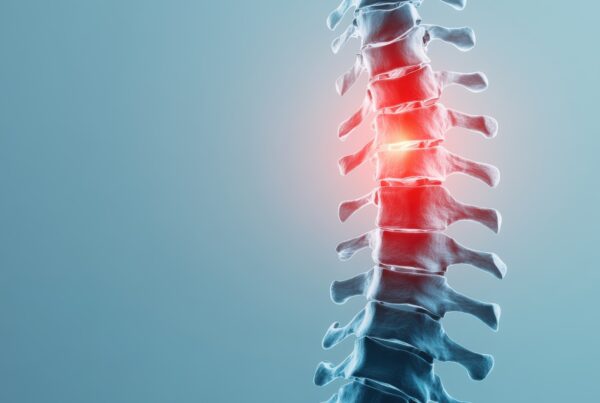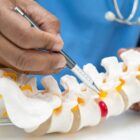Recovering from spine surgery is a journey that, with proper guidance and care, leads to significant pain relief and improved quality of life for most patients. At Neurosurgeons of New Jersey, we’ve helped thousands of patients successfully navigate this recovery process. While spine surgery recovery requires careful planning due to the involvement of your neck and back in daily activities, our experienced team will be with you every step of the way, ensuring you have the support and knowledge you need to heal correctly.
In this complete guide, you’ll learn essential spine surgery precautions for your cervical (neck), thoracic (mid-back), and lumbar (lower back) spine to minimize the risk of any setbacks or complications, as well as suggestions for modifying your daily activities during the recovery process.
Understanding Your Post-Surgical Recovery Timeline
While following precautions is essential, it is equally important to recognize that each milestone in your recovery brings you closer to resuming the activities you enjoy. Most of our patients report significant pain reduction even in the early weeks after surgery, with continued improvement as healing progresses. The temporary limitations you’ll experience during recovery are a small price to pay for the long-term benefits of reduced pain and improved function that successful spine surgery provides.
Precautions after spine surgery change during each phase of recovery. While you should always be cautious with your spine and especially the area where the surgery was performed, you will be approved to engage in additional activities as you progress through the recovery plan.
Minimally invasive spine surgeries typically allow for a faster recovery, with many patients returning to light activities within 3 to 4 weeks. Traditional open spine surgeries require a longer initial healing period of 6-12 weeks before you can gradually return to normal activities.
Here’s a general breakdown of the post-surgical recovery timeline for most minimally invasive spinal procedures.
Early Recovery Phase (First 1-2 Weeks)
The first one to two weeks after your surgery are among the most critical. You should closely follow your surgeon’s guidelines, which focus on pain control and wound healing. You should work diligently to keep the surgical site clean and exercise caution to minimize your risk of infection.
During the first two weeks after surgery, you may need assistance with daily activities, such as getting out of bed, walking to the bathroom, and preparing meals. Proper wound care is essential.
Follow your provider’s instructions to keep the surgical site clean. While your doctor may encourage you to walk, don’t push yourself too hard. Focus on resting as much as possible, taking a few short walks throughout the day.
Intermediate Recovery Phase (2-6 Weeks)
As your body begins to heal, your surgeon can guide you in gradually increasing your activity levels. You may start walking more frequently and performing basic tasks with specific movement restrictions to avoid stressing your spine. Bending and twisting are off limits during this phase. Lifting heavier objects is also something you should avoid.
Keep in mind that you should start to feel better during this phase. Don’t take that as a sign that you are fully healed. You have a long way to go and need to take things slowly to avoid any major setbacks.
Advanced Recovery Phase (6+ Weeks)
At this point, many patients transition to active rehabilitation. If you underwent a minimally invasive spine surgery, you will likely participate in physical therapy, core-strengthening exercises, and flexibility training.
Be honest with your physical therapy team about how you feel, so they can adjust your treatment plan to help you progress toward your goals.
If you start to feel pain or discomfort in your back, stop the activity immediately. Discuss your experiences with your provider and share as many details as possible.
Cervical Spine Surgery Precautions
Recovery from cervical (neck) spine surgery involves unique considerations to protect the delicate neck area while promoting healing.
Neck Movement Limitations
After cervical spine surgery, you’ll need to be particularly careful with neck movements:
- Avoid excessive turning, bending, or extending your neck
- Maintain a neutral neck position whenever possible
- Follow your surgeon’s guidelines regarding the use of a cervical collar or brace
- Be mindful of posture when using electronic devices to prevent neck strain
Swallowing and Voice Care
Some patients may experience temporary difficulty with swallowing or voice changes following anterior cervical procedures:
- Eat soft foods initially if swallowing is uncomfortable
- Take small bites and chew thoroughly
- Stay well-hydrated
- Report any persistent swallowing or voice issues to your surgical team
Thoracic Spine Surgery Precautions
Recovering from thoracic (mid-back) surgery requires a slightly different approach. Many of the guidelines focus on maintaining stability and promoting respiratory health. Here are the key precautions to follow for your spine after surgery on the thoracic spine.
Breathing Exercises and Pulmonary Care
Thoracic spine surgery can affect your respiratory mechanisms. Many of these effects are due to the disruption to the accessory muscles around your thorax, some of which assist with respiration. Additionally, discomfort that you experience post-op may discourage you from taking adequate breaths.
Here are a few ways your surgical team may encourage you to breathe more effectively after surgery:
- Using an incentive spirometer
- Taking slow, deep breaths throughout the day
- Coughing gently to clear secretions without straining yourself
- Practicing belly breathing to engage the diaphragm
These techniques help prevent pneumonia and other respiratory illnesses after mid-back surgery.
Trunk Movement Restrictions
After thoracic surgery, you should:
- Avoid twisting or rotating your upper body
- Be intentional with every movement
- Use a tool or ask for help when you need to reach high or low items
Following trunk movement precautions can help reduce your risk of complications, such as post-surgical injury.
Lumbar Spine Surgery Precautions
Your surgeon may provide you with a detailed list of lumbar spine surgery precautions to help you protect your spine after surgery. Some general tips they will likely provide include the following:
- Avoid bending or twisting at the waist
- Sit in a supportive chair
- Use the log-rolling technique when getting in and out of bed (turning your body as a single unit, keeping your back straight without twisting)
- Walk frequently but avoid high-impact activities
- Follow all lifting restrictions
Here’s a closer look at important lumbar spine surgery precautions to help support your recovery journey.
Proper Sitting Techniques After Lumbar Surgery
While you may be encouraged to walk as much as you can safely tolerate, you will also spend a significant amount of time sitting down during your recovery phase. Sitting incorrectly can place excess pressure on your healing lower back. To reduce strain, make sure that you:
- Use chairs with firm support and armrests
- Keep your hips slightly higher than your knees
- Sit upright with your back against the chair’s backrest
- Avoid slouching or leaning forward excessively
- Take frequent standing or walking breaks
Maintaining proper posture protects the spine, promotes better blood flow, and can reduce stiffness during recovery.
Safe Bending and Lifting Guidelines
Protecting your healing spine involves modifying your movement. Bending at the waist is strictly discouraged during the early stages of recovery. Instead, you should:
- Use your hips and knees to squat down rather than bending your back
- Keep objects close to your body when lifting
- Avoid twisting while lifting or carrying anything
- Never lift objects heavier than your surgeon recommends
Following these techniques helps prevent damage to surgical repairs and promotes proper spine healing.
Walking and Physical Activity Progression
One of the most essential precautions after lumbar spine surgery is gradually increasing your activity. Walking is likely your primary form of exercise during the recovery process. Begin with short, frequent walks around your home. Gradually increase the duration and distance as tolerated.
Walking can help improve circulation and support lung function. Getting up and walking around can also help reduce your risk of blood clots.
It's time to get back
to doing what you love.
Daily Activity Modifications During Recovery
Resuming everyday activities after spine surgery requires adjustments to movement, sleep patterns, and self-care. These adjustments help prevent accidental injury and promote a smoother healing journey.
Sleep Positioning and Bedding Recommendations
Most people have preferred sleeping positions. Adjusting to how you sleep after surgery can be a significant challenge, especially when trying to rest and recover. However, it’s important to follow your surgeon’s recommendations, which may include the following:
- Putting a pillow under your knees and sleeping on your back
- Using a pillow between your knees and sleeping on your side
- Using a firm mattress that supports your natural spinal curve
- Avoiding stomach sleeping
You may want to invest in high-quality pillows and, potentially, a mattress topper before your procedure. Consult with your care team to determine the most effective approach to support your healing process.
Personal Care Adaptations (Bathing, Dressing)
Bathing and dressing will be challenging in the first few weeks after your surgery. Here are a few tips to make personal care easier:
- Use a shower chair or grab bars
- Avoid bending or twisting to wash your lower body
- Use long-handled tools to assist with dressing
- Wear slip-on shoes to avoid bending over
You may need assistance with these basic activities, especially in the first few days after your procedure.
Driving and Travel Considerations
Driving is typically restricted until your surgeon confirms it is safe. Discuss with your surgeon when you can resume driving and traveling. When you resume driving, take frequent breaks to help prevent stiffness. You should also avoid abrupt twisting movements when getting in and out of the car.
Warning Signs: When to Contact Your Surgeon
Even if you follow all of these precautions after spine surgery, you may still encounter concerns that you aren’t healing as planned. Always err on the side of caution if symptoms arise.
Signs of Infection or Wound Complications
Contact your surgeon immediately if you notice:
- Increased redness, swelling, or warmth around the incision
- Pus-like drainage or foul odors
- A sudden increase in pain at the surgical site
Don’t put off treatment if you believe you are developing an infection.
Neurological Symptoms Requiring Attention
You need medical treatment as soon as possible if you experience any of the following:
- New tingling or weakness
- Loss of bladder or bowel control
- Difficulty walking or maintaining balance
These are neurological symptoms that could indicate a very serious issue.
Physical Therapy and Rehabilitation After Spine Surgery
Attending physical therapy can help you safely work on your strength and flexibility after surgery. Specialized spine rehabilitation experts closely coordinate with your surgeon to create a personalized therapy program tailored to your specific procedure and recovery needs. Unlike general physical therapy, spine rehabilitation protocols are explicitly designed for spine surgery patients, incorporating the latest evidence-based techniques for optimal recovery. This specialized approach leads to better outcomes and reduced patient recovery times.
When to Begin Physical Therapy
You will likely start PT a few weeks after your procedure. Your physical therapist can guide you through basic exercises that help improve your range of motion and flexibility. They may introduce some basic strength training movements several weeks into your therapy.
Key Rehabilitation Exercises
Your exercise regimen may include the following movements:
- Core stabilization exercises to support your spine
- Stretching
- Weightlifting to strengthen your lower back
- Basic training to help you perform daily activities safely
Make sure you follow the plan and don’t skip any appointments. If you are feeling sore or uncomfortable, tell your physical therapist.
Returning to Work and Daily Activities
Most patients’ top concerns are getting back to work and their normal daily routine. However, there is no one-size-fits-all timeline after spine surgery. When you can return to work largely depends on the physical demands of your job, the procedure you underwent, and your overall health.
Office and Sedentary Work Considerations
If you have a desk-based job, you can return to work sooner than someone with a physically demanding job. However, you should still take some precautions to protect your spine. Here are a few tips:
- Use an ergonomic chair with lumbar support
- Set reminders to stand and stretch every 30-45 minutes
- Position your computer screens at eye level to avoid neck strain
These simple changes can help prevent stiffness during long work hours.
Physical Labor and Active Job Accommodations
If you work a physical job, you must be extra cautious when returning. You may require work restrictions or light duty for several months. Make sure that you follow any lifting limits set by your surgeon. Lifting too much weight too soon can lead to serious consequences and may result in you needing to undergo another surgery.
Long-Term Spine Health After Surgery
Maintaining your spine health doesn’t stop after recovery. Setting good long-term habits can help protect your back and increase your odds of living a life free from chronic pain. Regular exercise and maintaining good posture are vital for maintaining lasting spine health.
Most of our patients report dramatic improvements in their quality of life following spine surgery. Many return to activities they once thought impossible—from playing with grandchildren to resuming favorite sports or simply enjoying a good night’s sleep without pain. By closely following your recovery guidelines and adopting the long-term spine health practices we recommend, you’re setting yourself up for years of improved mobility and comfort.
Exercise and Activity Recommendations
Even after you reach the end of your recovery plan, continue to engage in:
- Core strengthening programs
- Low-impact cardiovascular activities like walking, swimming, or cycling
- Spine-safe exercises like yoga or Pilates
Eventually, you should be able to resume weightlifting and more rigorous exercise. However, your surgeon may still place some limitations on what you are allowed to do.
Ergonomics and Posture Maintenance
Don’t forget about proper posture after you complete your physical therapy. Make sure that you:
- Use proper posture when sitting, standing, and lifting
- Avoid excessive twisting or straining
- Buy an ergonomic chair
Spine surgery can reduce or alleviate chronic back pain. However, it’s up to you to take care of your back after your procedure.
Why Choose Neurosurgeons of New Jersey for Your Spine Care?
At Neurosurgeons of New Jersey, we specialize in providing personalized, expert spine care before, during, and after surgery. Our team uses advanced, minimally invasive techniques whenever possible to minimize recovery time and maximize the chances of positive outcomes.
Unlike generalized practices, each of our neurosurgeons focuses on specific subspecialties within spine care. This focused expertise means you receive treatment from a surgeon dedicated to mastering the exact type of procedure you need. Our spine specialists have completed advanced fellowship training at prestigious institutions and remain at the forefront of emerging minimally invasive techniques. This specialized approach enables us to achieve superior outcomes with faster recovery times than traditional surgical methods.
From your first consultation through your post-operative care, we guide you through each stage of the surgical process. We work closely with both our in-house physical therapist and a network of specialized rehabilitation professionals to ensure continuity of care. Request a consultation with our spine specialists to discuss your condition and treatment options.
FAQs
How Long Will I Need to Take Pain Medication After Spine Surgery?
Most patients use prescription pain medications for one to two weeks post-surgery before gradually transitioning to over-the-counter options. Always follow your surgeon’s specific guidance.
When Can I Shower After Spine Surgery?
Your surgeon will provide instructions regarding when you can shower. Typically, you can shower when your surgical site is dry and clean, as long as it is not draining.
How Long Should I Wear a Back Brace Following Surgery?
You may need to wear a back brace for 4-12 weeks after your surgery. Your timeframe will vary based on the site of your procedure and the type of surgery you undergo. If you are instructed to wear a back brace, follow your healthcare provider’s guidance carefully.
When Can I Resume Intimate Activities After Spine Surgery?
Your provider will likely recommend that you wait at least six weeks before resuming intimate activities. However, you may need to wait longer depending on your progression and the type of surgery you undergo. You may also need to follow certain precautions during intimate activities to avoid straining your spine.
What Sleeping Position Is Best After Spine Surgery?
Sleeping on your back with a pillow under your knees or on your side with a pillow between your knees are ideal positions. The pillow helps support your spine and reduce strain on the incision site.
When Can I Start Driving After Spine Surgery?
Most patients can resume driving two to four weeks after surgery. You will have to wait until you are off narcotic pain medication. You should also wait until you can safely turn to check your mirrors or look out your windows before proceeding through intersections.
How Soon Can I Return to Sports and Exercise?
Begin taking brief walks around your home as soon as possible. However, you may need to wait several months before resuming more intensive exercise or sports. Avoid contact sports and high-impact activities until your surgeon has given you clearance.
Will I Need Someone to Help Me at Home After Surgery?
Yes, you will need someone to drive you home after your spine surgery. You may also require assistance during the first few weeks after your procedure.
Plan and avoid trying to take care of yourself independently, especially if the activity involves bending, lifting, or reaching. Something as simple as reaching for an item in a kitchen cabinet could strain your spine.

About Livingston
Our team of board certified physicians, located in Livingston, New Jersey, are dedicated to bringing you the latest developments and treatment options for spinal surgery. We strive to produce the most clarified & clear content to help you make informed decisions on your medical journey. The road to feeling like your true self should not feel lonely- Let us help you. Please call us to schedule a consultation and speak to one of our team members.






